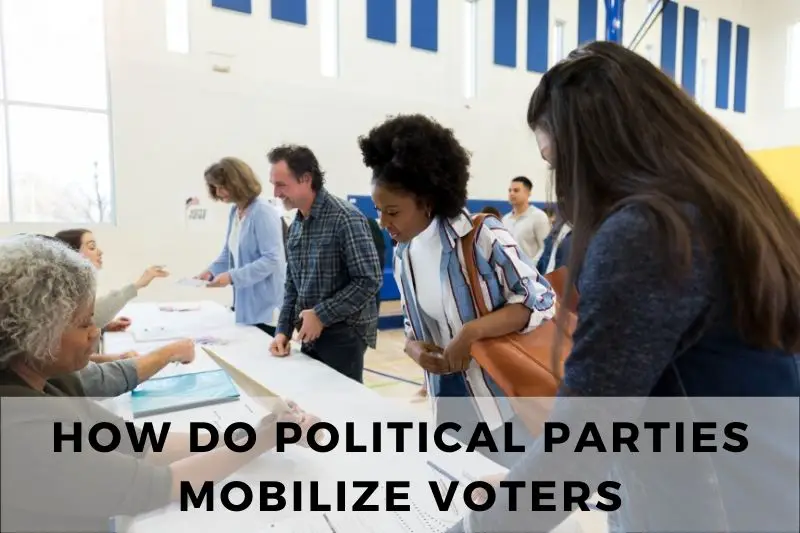
Political parties play a pivotal role in the democratic process, serving as the conduits through which citizens engage with the political system. Understanding how political parties mobilize voters is essential for comprehending the dynamics of elections. This article aims to dissect various strategies employed by political parties to mobilize voters, ranging from traditional methods like door-to-door canvassing to modern digital campaigning techniques. By delving into these methods, we gain insight into the intricate mechanisms underlying political mobilization efforts.
How Do Political Parties Mobilize Voters
#1. Door-to-Door Canvassing
Door-to-door canvassing remains a cornerstone of political mobilization efforts. Volunteers and party members visit residences to engage voters directly. This method allows for personalized interactions, enabling parties to convey their message and garner support. By knocking on doors, parties can identify supporters, undecided voters, and opponents, tailoring their approach accordingly.
#2. Phone Banking
Phone banking involves contacting voters via telephone calls. It allows parties to reach a large audience efficiently. Volunteers engage in conversations, disseminate information, and encourage voter turnout. While less personal than door-to-door canvassing, phone banking remains a valuable tool for voter mobilization, especially in reaching individuals who may be inaccessible through other means.
#3. Neighborhood Events
Neighborhood events provide platforms for direct engagement between political parties and local communities. These gatherings, ranging from informal meet-and-greets to organized rallies, facilitate face-to-face interactions. By participating in neighborhood events, parties can connect with voters on a personal level, address concerns, and rally support around their candidates and policies.
#4. Campaign Literature Distribution
Distributing campaign literature is a traditional yet effective method of voter mobilization. Parties produce pamphlets, flyers, and brochures containing information about their candidates, platforms, and key messages. Volunteers distribute these materials in various settings, including doorsteps, public events, and mailboxes, increasing visibility and awareness among voters.
#5. Digital Campaigning
In the digital age, political parties leverage online platforms to mobilize voters effectively. Digital campaigning encompasses social media engagement, email outreach, and targeted advertising. Through platforms like Facebook, Twitter, and Instagram, parties disseminate information, solicit donations, and rally supporters. Digital campaigning offers unparalleled reach and allows parties to tailor messages to specific demographics.
#6. Targeted Messaging
Targeted messaging involves tailoring communication to specific demographic groups or individuals based on their characteristics or preferences. Parties utilize data analysis to identify key issues and concerns among different segments of the electorate. By crafting messages that resonate with target audiences, parties can effectively mobilize support and sway undecided voters.
#7. Voter Registration Drives
Voter registration drives aim to increase the number of eligible voters participating in elections. Parties organize registration efforts in communities, universities, and public spaces. Volunteers assist individuals in completing registration forms and provide information about voting procedures. Voter registration drives are crucial for expanding the electorate and ensuring broader participation in the democratic process.
#8. Get-Out-The-Vote (GOTV) Efforts
Get-Out-The-Vote (GOTV) efforts focus on encouraging registered voters to cast their ballots on Election Day. Parties employ various tactics, including door-to-door reminders, phone calls, and targeted messaging. Volunteers emphasize the importance of voting, provide information about polling locations, and offer transportation assistance if needed. GOTV efforts are instrumental in translating support into actual votes.
#9. Community Outreach
Community outreach initiatives involve engaging with local organizations, leaders, and stakeholders to build relationships and foster support. Parties collaborate with community groups, religious institutions, and civic organizations to address shared concerns and mobilize grassroots support. By participating in community events and initiatives, parties demonstrate their commitment to addressing local issues and earning the trust of voters.
#10. Debates and Town Halls
Debates and town halls provide platforms for candidates to engage directly with voters and articulate their positions on key issues. Parties organize these events to showcase their candidates’ abilities, vision, and policies. Voters have the opportunity to ask questions, express concerns, and evaluate candidates’ responses. Debates and town halls play a vital role in shaping voter perceptions and influencing electoral outcomes.
#11. Political Advertising
Political advertising encompasses a wide range of media channels, including television, radio, print, and online platforms. Parties invest significant resources in crafting persuasive messages and targeting specific audiences. Advertisements highlight candidates’ achievements, policies, and contrasts with opponents. By saturating media channels with strategic messaging, parties aim to shape public opinion and influence voter behavior.
#12. Volunteer Recruitment and Training
Volunteer recruitment and training are essential components of effective voter mobilization efforts. Parties rely on dedicated volunteers to execute various campaign activities, including canvassing, phone banking, and event organizing. Recruitment efforts involve reaching out to party members, supporters, and community members. Training sessions provide volunteers with the necessary skills, knowledge, and resources to effectively engage with voters and represent the party’s interests.
#13. Data Analytics
Data analytics play a crucial role in modern political mobilization strategies. Parties collect and analyze vast amounts of data, including voter demographics, preferences, and behaviors. Advanced analytics techniques enable parties to identify swing voters, micro-target specific demographics, and optimize campaign strategies. By leveraging data-driven insights, parties can allocate resources efficiently and maximize their impact on voter mobilization.
#14. Encouraging Peer-to-Peer Influence
Encouraging peer-to-peer influence involves empowering supporters to mobilize their peers and networks. Parties facilitate grassroots organizing efforts, providing supporters with tools and resources to advocate for their candidates and causes. Peer-to-peer influence can be more persuasive than traditional campaign messaging, as it relies on personal relationships and trust. Parties encourage supporters to share their experiences, engage in conversations, and mobilize their social circles to support the party’s objectives.
#15. Ethnic and Minority Outreach
Ethnic and minority outreach initiatives aim to engage with diverse communities and address their unique concerns and interests. Parties recognize the importance of representing and advocating for all segments of society. Outreach efforts involve building relationships with ethnic and minority leaders, participating in cultural events, and addressing issues relevant to these communities. By demonstrating inclusivity and understanding, parties can mobilize support and strengthen their electoral coalitions.
Closing Thoughts
Understanding the diverse strategies employed by political parties to mobilize voters is essential for comprehending the intricacies of democratic elections. From traditional methods like door-to-door canvassing and campaign literature distribution to modern digital campaigning and data analytics, parties employ a multifaceted approach to engage with voters and rally support. By harnessing the power of community outreach, targeted messaging, and peer-to-peer influence, parties navigate the complexities of the political landscape, striving to mobilize diverse constituencies and secure electoral success. In the ever-evolving realm of politics, effective voter mobilization remains a cornerstone of democratic governance.
